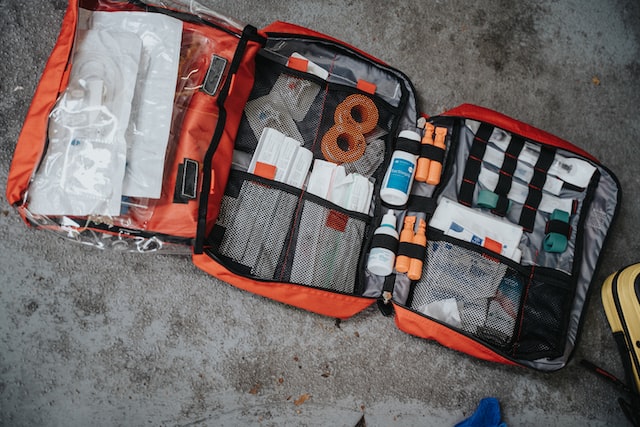- Section 1: The Power of Psychiatric Service Dogs
- Section 2: Choosing the Right Dog and Training Program
- Section 3: The Journey of Training a Psychiatric Service Dog
- Section 4: Training Techniques and Positive Reinforcement
- Section 5: Addressing Challenges in Training
- Section 6: Legal Aspects and Certification
- Section 7: The Transformative Impact on Lives

Living with mental health challenges can be incredibly tough, but for many individuals, the support and companionship of a psychiatric service dog can be life-changing. These remarkable canines, with their innate ability to sense emotions and provide comfort, are trained to assist people with psychiatric disabilities in managing their conditions and regaining independence. In this comprehensive blog post, we will delve deep into the profound impact of psychiatric service dogs and the training process that transforms them into dedicated healers and empowering companions.
Section 1: The Power of Psychiatric Service Dogs
1.1 Understanding the Role of Psychiatric Service Dogs: Beyond Emotional Support:
Psychiatric Service Dogs (PSDs) play a crucial role in providing much more than just emotional support to individuals facing mental health challenges. These specially trained canines serve as devoted companions, offering a unique set of skills and assistance that go beyond traditional emotional support animals. While emotional support animals offer comfort and companionship, PSDs are trained to perform specific tasks that aid individuals with psychiatric disabilities in their daily lives.
1.2 The Science Behind the Healing Connection: How Dogs Help Improve Mental Health
The human-animal bond is a powerful and fascinating phenomenon that has been observed for centuries. Among the various animals, dogs have earned a special place in our hearts as loyal companions and steadfast friends. But their significance goes beyond mere companionship. Scientific research has unveiled a plethora of evidence supporting the idea that dogs can significantly impact our mental health and well-being.
1.3 Benefits of Having a Psychiatric Service Dog: Reducing Stress and Anxiety
One of the most significant benefits of having a PSD is the profound reduction of stress and anxiety levels. These specially trained dogs have an innate ability to sense emotional distress in their handlers, and they respond with comforting behaviors that help alleviate tension and promote relaxation. Whether it's providing a reassuring nuzzle during moments of distress or guiding their handlers away from triggering situations, PSDs act as invaluable sources of emotional grounding and stability.
Section 2: Choosing the Right Dog and Training Program
2.1 Identifying the Ideal Candidate: Traits to Look for in a Psychiatric Service Dog
Choosing the right Psychiatric Service Dog (PSD) is a crucial decision that can profoundly impact the well-being of individuals facing mental health challenges. To ensure a successful partnership, it is essential to identify the ideal candidate with the right temperament and characteristics that suit the handler's specific needs.
One of the key traits to look for in a PSD is a calm and stable temperament. These dogs must remain composed in various situations, especially during moments of emotional distress when their handlers rely on their support the most. Additionally, a well-behaved PSD should exhibit a friendly and gentle demeanor towards both their handlers and strangers, as they may accompany their owners in public spaces.
Another vital characteristic of an ideal PSD is their intelligence and willingness to learn. These dogs undergo rigorous training to perform specific tasks that aid individuals with psychiatric disabilities. A quick learner with a high level of trainability is essential to ensure they can execute tasks efficiently and effectively.
Furthermore, a good PSD should have a strong bond and connection with their handler. This emotional connection fosters trust and understanding, allowing the dog to better sense and respond to their handler's emotional cues.
By carefully evaluating these traits and conducting thorough assessments, it is possible to find the perfect Psychiatric Service Dog that will become a loyal and indispensable companion, significantly enhancing the lives of those who rely on their support.
2.2 Professional vs. Owner-Training: Pros and Cons for Both Approaches
When it comes to acquiring a Psychiatric Service Dog (PSD), individuals have two primary options: professional training or owner-training. Each approach has its own set of pros and cons, and understanding these differences is essential for making an informed decision.
Professional training involves seeking the expertise of experienced trainers who specialize in training service dogs. These professionals have in-depth knowledge of the specific tasks and behaviors required of a PSD. The main advantage of this approach is the assurance of a highly trained and reliable dog. Professional training often includes a structured curriculum, socialization with other dogs, and exposure to various environments, ensuring the PSD is well-prepared for any situation. However, the cost of professional training can be significant, and there may be a waiting period to obtain a trained dog.
On the other hand, owner-training involves training the PSD by the individual or their family members. This approach allows for a unique bond to form between the dog and its handler from the very beginning. Additionally, owner-training offers flexibility in customizing the training to suit the specific needs of the handler. However, owner-training requires a significant time commitment and requires access to reliable resources and training materials. There is also a risk of inconsistencies in the training, which may impact the dog's reliability in performing tasks.
Ultimately, the decision between professional and owner-training depends on individual circumstances, such as budget, time availability, and the handler's willingness to invest in training. Whether choosing professional training or embarking on owner-training, the ultimate goal remains the same: to establish a strong and reliable partnership between the Psychiatric Service Dog and its handler, creating a life-changing bond that enhances the handler's quality of life.
2.3 Selecting a Reputable Training Program: Factors to Consider
Choosing the right training program for a Psychiatric Service Dog (PSD) is a critical step in ensuring the success of the dog-handler partnership. With numerous options available, it can be overwhelming to select a reputable training program that best suits individual needs. Consider these essential factors when making this crucial decision.
Experience and Expertise: Look for a training program with a proven track record of successfully training PSDs. Research the trainers' qualifications, experience, and certifications to ensure they possess the expertise required to train a service dog.
Training Methods: Inquire about the training methods used in the program. Positive reinforcement-based methods are generally preferred, as they create a positive and trusting relationship between the dog and its handler.
Customization: Each individual's needs are unique, and a reputable training program should be able to tailor the training to suit the handler's specific requirements and disability.
References and Reviews: Read reviews and seek recommendations from previous clients of the training program. Positive testimonials can provide valuable insights into the program's effectiveness and professionalism.
Accreditation: Check if the training program is accredited by relevant service dog organizations or affiliated with reputable associations in the field.
Support and Follow-Up: A reputable training program should offer ongoing support and follow-up to ensure the successful transition of the PSD into its new home.
Cost and Duration: Consider the cost of the training program and the duration required for the dog's training. Balance these factors with the quality of training provided.
By carefully evaluating these factors and asking the right questions, individuals can confidently select a reputable training program that will result in a well-trained and reliable Psychiatric Service Dog, ultimately enhancing the handler's quality of life and fostering a strong and supportive bond between the dog and its handler.
Section 3: The Journey of Training a Psychiatric Service Dog
3.1 Puppy Selection and Socialization: Setting the Foundation for Success
The journey of raising a Psychiatric Service Dog (PSD) begins with one crucial step: puppy selection and socialization. Choosing the right puppy and providing early socialization lays the groundwork for a successful and well-adjusted service dog.
When selecting a puppy for service training, it is essential to look for specific traits and characteristics that align with the requirements of a PSD. A puppy should display a calm and stable temperament, showing confidence and adaptability in various situations. Additionally, a good candidate should exhibit a willingness to learn and a strong desire to please, making training more effective and enjoyable.
A reputable training program or experienced owner-trainer will create a carefully planned socialization program to gradually introduce the puppy to various stimuli in a positive and controlled manner. This approach builds the puppy's self-assurance, fosters a positive outlook on the world, and establishes the groundwork for a successful service dog.
By focusing on puppy selection and socialization, handlers can set their PSDs on a path to success, leading to a confident, reliable, and well-adjusted service dog ready to provide invaluable support and companionship in the years to come.
3.2 Core Training Phases: From Basic Obedience to Specialized Skills
The training journey of a Psychiatric Service Dog (PSD) is a meticulously planned and progressive process, encompassing various core training phases. Each phase plays a vital role in shaping the PSD's abilities and ensuring they can fulfill their role as a reliable and effective service dog.
Basic Obedience: The foundation of a well-trained PSD begins with basic obedience. During this phase, the dog learns essential commands such as sit, stay, come, and heel. These commands serve as the building blocks for further training and lay the groundwork for effective communication between the dog and its handler.
Public Manners: As a PSD accompanies its handler in public spaces, it is crucial for them to exhibit impeccable manners. This phase focuses on teaching the dog to remain calm, focused, and well-behaved in various environments, ensuring their presence is unobtrusive and comfortable for both the handler and those around them.
Task Training: Task training is the heart of a PSD's training journey. During this phase, the dog learns specialized tasks that directly assist their handler's psychiatric disabilities. These tasks may include detecting signs of anxiety or panic attacks, interrupting harmful behaviors, retrieving medication, or providing deep pressure therapy.
3.3 Integrating Public Access Training: Preparing the Dog for Real-Life Scenarios
One of the most critical phases in the training journey of a Psychiatric Service Dog (PSD) is public access training. This phase focuses on acclimating the dog to real-life situations and preparing them to be confident and well-behaved in public spaces. Integrating public access training is a gradual process that requires patience, consistency, and positive reinforcement.
During public access training, the PSD learns to remain focused on their handler while navigating various environments, such as shopping malls, restaurants, public transportation, and crowded streets. They must be able to ignore distractions and remain attentive to their handler's needs, ensuring a seamless and unobtrusive presence in public settings.
A structured approach is essential in integrating public access training. The dog begins in low-distraction environments and gradually progresses to more challenging scenarios. Controlled exposure to different situations, noises, and people helps the dog build confidence and adaptability.
Handlers and trainers play a crucial role in supporting the dog's progress. Reward-based training methods are utilized to reinforce positive behavior and maintain the dog's enthusiasm for their role as a service dog. Consistent reinforcement of desired behaviors ensures the PSD remains focused and responsive, even in stimulating public environments.
The successful integration of public access training is a testament to the dedication and commitment of the training team.
Section 4: Training Techniques and Positive Reinforcement
4.1 Positive Reinforcement: An Effective and Compassionate Approach to Training
Positive reinforcement is a powerful and humane training method that has gained widespread recognition for its effectiveness in shaping desired behaviors in dogs, including Psychiatric Service Dogs (PSDs). This training approach relies on rewarding the dog for exhibiting the desired behavior, thereby encouraging them to repeat it in the future.
Instead of using punishment or aversive methods, positive reinforcement focuses on rewarding the dog with treats, praise, or affection when they perform the desired action. By associating the behavior with positive outcomes, the dog learns to willingly and eagerly engage in the behavior to receive the reward.
This approach not only enhances the dog's learning experience but also strengthens the bond between the dog and its handler. Positive reinforcement fosters a sense of trust and cooperation, as the dog associates their handler with positive experiences.
Positive reinforcement is especially effective in training PSDs because it allows them to perform their tasks with confidence and enthusiasm. These highly sensitive and empathetic dogs respond well to the kindness and support provided through positive reinforcement, enabling them to fulfill their role as empathetic companions and reliable service dogs.
4.2 Clicker Training and Its Benefits: Enhancing Communication and Learning
Clicker training is a popular and highly effective training technique used to teach Psychiatric Service Dogs (PSDs) and other dogs new behaviors and tasks. This method relies on a small handheld device, known as a clicker, which emits a distinctive sound when pressed. The sound of the clicker serves as a clear and precise marker to communicate with the dog, indicating the exact moment they have performed the desired behavior.
One of the key benefits of clicker training is its precision in communication. The clicker allows handlers to provide instant feedback to the dog, signaling that they have done something right. This immediate feedback helps the dog understand which action earned them a reward, making the learning process quicker and more efficient.
4.3 Building Trust and Communication: The Key to Successful Training
Establishing trust begins from the moment the PSD joins the handler's life. Handlers must create a safe and nurturing environment for their canine companion, where the dog feels secure and valued. Positive reinforcement and gentle training methods play a crucial role in building trust, as the dog learns that their handler is a source of encouragement and support.
Clear and consistent communication is equally essential in the training process. Handlers use verbal cues, hand signals, and body language to communicate with their PSD effectively. By using consistent cues and rewards, the dog learns to associate specific behaviors with positive outcomes, leading to a deeper understanding between the handler and the PSD.
Section 5: Addressing Challenges in Training
5.1 Common Behavioral Challenges: How to Overcome Fear and Aggression
Fear: Fear is a common behavioral challenge faced by dogs, including PSDs. It may arise from past negative experiences or lack of socialization during the critical developmental period. To overcome fear, gradual desensitization and counterconditioning techniques can be employed. Introducing the dog to the trigger in a controlled and positive manner while rewarding calm and relaxed behavior helps them build confidence and associate the trigger with positive experiences.
Aggression: Aggression in PSDs can be a concerning issue, especially in public settings. Aggression may stem from fear, anxiety, or a sense of protectiveness towards their handler. Professional intervention from a qualified dog behaviorist is essential in addressing aggression. Positive reinforcement-based behavior modification techniques, along with proper management and controlled exposure to triggering situations, can help reduce aggressive tendencies.
5.2 Training for Specific Psychiatric Disabilities: Tailoring Skills to Individual Needs
Each handler's needs are unique, and the training of a PSD is tailored to meet those specific requirements. The training process is highly individualized and requires a deep understanding of the handler's disability and their specific needs. Professional trainers work closely with the handler to assess their requirements and design a training plan that targets the necessary skills.
5.3 Progress Monitoring: Tracking Milestones and Celebrating Achievements
Tracking milestones is essential in understanding the dog's development. It involves setting specific training goals and observing the dog's growth in acquiring new behaviors and tasks. Celebrating achievements, no matter how small, boosts the dog's confidence and reinforces positive behaviors.
Positive reinforcement plays a significant role in progress monitoring. Praising the PSD for successfully completing tasks and rewarding their efforts with treats or affection strengthens the bond between the dog and its handler, fostering enthusiasm for continued learning.
Section 6: Legal Aspects and Certification
6.1 Understanding the Legal Rights: The Americans with Disabilities Act (ADA) and Service Dogs
The Americans with Disabilities Act (ADA) is a crucial piece of legislation that protects the rights of individuals with disabilities, including those who rely on the assistance of service dogs. Understanding the legal rights provided by the ADA is essential for both handlers and the general public to ensure that service dogs are treated with respect and allowed to perform their vital tasks without discrimination.
Under the ADA, a service dog is defined as a dog that is individually trained to perform tasks that mitigate a person's disability. These tasks can include anything from guiding individuals who are blind, alerting those who are deaf, providing mobility assistance, or even offering emotional support to individuals with psychiatric disabilities.
One of the fundamental rights granted by the ADA is the public access rights for service dogs. Service dogs are permitted to accompany their handlers in almost all public places, including restaurants, stores, hotels, public transportation, and other places open to the public. This includes places where pets are typically not allowed.
It's important to note that businesses and establishments can only ask limited questions regarding the service dog's tasks and should not require the service dog to wear a vest or any identification. They are also not allowed to charge additional fees for the presence of a service dog.
6.2 Certification and Public Access Rights: Dispelling Myths and Clarifying Facts
Certification and public access rights are hot topics when it comes to Psychiatric Service Dogs (PSDs) and other service dogs. It is essential to understand the facts and dispel common myths to promote a clear understanding of the legal rights of service dog handlers.
Myth 1: Service Dogs Must Be Certified Fact: The Americans with Disabilities Act (ADA) does not require service dogs to be certified. There is no official or government-recognized certification process for service dogs. Handlers are not obligated to carry any specific documents or ID for their service dogs.
Myth 2: Service Dogs Require Special Vests or Identification Fact: The ADA does not mandate that service dogs wear vests, patches, or other identification. While some handlers may choose to use these items for convenience, they are not legally required to do so. Businesses and establishments cannot demand proof or identification of a service dog's training.
Myth 3: Emotional Support Animals Have Public Access Rights Fact: Emotional support animals (ESAs) do not have the same public access rights as service dogs. ESAs provide emotional comfort but are not individually trained to perform specific tasks. Only service dogs that are trained to mitigate a person's disability have public access rights under the ADA.
Myth 4: Service Dogs Can Be Denied Access Based on Breed or Size Fact: The ADA does not impose any restrictions on the breed or size of service dogs. Businesses and establishments cannot deny access to a service dog solely based on its breed or size, as long as the dog is well-behaved and under control.
By understanding the facts and dispelling myths, we can create a more inclusive and welcoming environment for service dog handlers. Respecting the rights of service dog handlers helps ensure that these highly trained and dedicated animals can continue to provide invaluable assistance and support to individuals with disabilities in all public spaces.
6.3 Traveling and Accommodation: Navigating the World with a Psychiatric Service Dog
When traveling with a PSD, it's important to be aware of the rights granted by the Americans with Disabilities Act (ADA). The ADA allows service dogs to accompany their handlers in public places, including airports, airplanes, hotels, and other lodging establishments. Airline carriers must accommodate service dogs in the cabin, though it's advisable to inform the airline in advance to ensure appropriate seating and facilities.
When booking accommodations, it's essential to communicate with hotels and lodging establishments about the presence of a service dog. While hotels cannot charge additional fees for service dogs, informing them in advance helps ensure a smooth check-in process and a comfortable stay.
Traveling with a PSD also requires thoughtful preparation. Packing essentials such as food, water, toys, and necessary medication for the dog is crucial. Ensuring the dog is well-rested and has had enough exercise before embarking on a journey helps them remain calm and focused during travel.
Section 7: The Transformative Impact on Lives
7.1 Personal Stories of Triumph: Real-Life Testimonials from Handlers and Their Dogs
Many handlers share stories of triumph over anxiety and depression, thanks to the unwavering presence of their PSDs. These remarkable dogs are trained to detect signs of distress and respond with comforting behaviors, providing a sense of security and grounding during moments of emotional turbulence. You may check some of our student stories at Our Stories.
7.2 Breaking Stigma: The Role of Psychiatric Service Dogs in Mental Health Advocacy
PSDs not only assist their handlers in navigating the world with confidence but also serve as powerful agents of change in mental health advocacy. Their presence and impact extend far beyond their specialized tasks, contributing to a more understanding and supportive environment for individuals living with mental health challenges.
7.3 Expanding Accessibility: Initiatives to Provide Service Dogs to Those in Need
The demand for Psychiatric Service Dogs (PSDs) continues to grow as more individuals recognize the invaluable support these dogs provide for mental health challenges. However, acquiring a well-trained service dog can be costly and present barriers to accessibility for some. To combat these issues, SDTSI is working towards increasing access by providing affordable training courses for people looking to train to their psychiatric service dog.
Conclusion
Psychiatric service dogs are more than just well-trained companions; they are devoted healers who empower individuals to navigate their mental health challenges with newfound confidence. From the intensive training process to the profound impact they have on their handlers' lives, these remarkable canines are changing the way we perceive and manage mental health conditions. By understanding the significance of their roles, the training techniques that mold them, and the legal aspects that protect their rights, we can celebrate the incredible contributions of psychiatric service dogs to the world of mental health and wellness.












